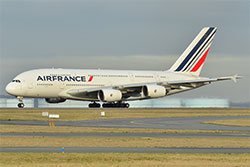French Report Finds Metal Safety Risk Caused Engine Blowout In A380 Written 30 September 2020
In This Section

Airbus A380-800 Air France at Roissy-Charles de Gaulle Airport (LFPG). | Laurent ERRERA from L’Union, France; Wikipedia; CC BY-SA 2.0
Bloomberg reports that “a three-year French investigation into a near-catastrophic Airbus SE A380 engine blowout over Greenland found hidden weaknesses in the structure of a widely used metal alloy, with safety implications for plane equipment worldwide.” Microscopic “cracks beneath the surface of a titanium alloy caused one engine on an Air France superjumbo to break apart during” a September 30, 2017 flight, according to a Tuesday presentation of a report by France’s “air-crash authority, Bureau d’Enquetes et d’Analyses.” The BEA report “concluded that a crack developed underneath the surface due to so-called ‘cold dwell’ fatigue in the metal.” The “titanium alloy, called Ti-6-4, has been widely used to make aircraft equipment since the 1970s because of its strength and relative light weight.” The engine, a GP7270, “was made by Engine Alliance, a joint venture between General Electric Co. and Raytheon Technologies Corp.’s Pratt & Whitney unit.”
Full Story (Bloomberg)
